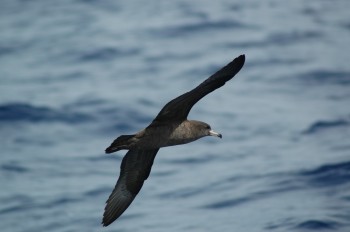Jenn Lavers (Institute for Marine and Antarctic Studies, University of Tasmania, Hobart, Tasmania, Australia) and colleagues published in the journal Marine Ecology Progress Series last year on using feather analyses of from Flesh-footed Shearwaters Puffinus carneipes killed at sea to trace their breeding sites.
The paper’s abstract follows:
“An emerging issue in seabird conservation is the ability to link at-sea mortality with observed demographic changes at breeding colonies. Applications of modelling and biochemical markers can be used to assign mortalities of unknown provenance to a colony of origin ensuring conservation actions are targeted at those colonies identified as the most affected. We analysed feathers (n = 120) from flesh-footed shearwater Puffinus carneipes collected from 5 breeding colonies throughout their range. Using stable isotopes (δ15N and δ13C) and trace element concentrations (Mn, Ni, Cu, Mo, Ag, Ba, Pb), we assigned birds recovered from fishing vessels off Australia, New Zealand, and the North Pacific to colony of origin, and investigated the rate of correct assignment at 3 spatial scales. Using quadratic discriminant analysis, samples of known origin were correctly assigned to basin, region, and breeding colonies at similar rates (92.3, 81.3, and 88.1%, respectively). Stable isotopes succeeded in assigning individuals among basins (72.8%), performing less well at the region and colony level (52.5 and 36.4%, respectively). In contrast, correct assignment was consistent at all 3 scales using only trace elements (93.2, 95.7, and 96.6%, respectively). Applying our final model based on trace elements to 116 flesh-footed shearwaters taken as bycatch in eastern Australia (n = 30), Western Australia (n = 32), New Zealand (n = 16), eastern North Pacific (n = 27) and western North Pacific (n = 11), we assigned individuals to colonies in New Zealand (35.3%), Western/South Australia (36.2%), Western Australia (27.6%), and Lord Howe Island (0.9%). Bycatch in fisheries may help explain ongoing declines in flesh-footed shearwater populations across the species’ range, highlighting the utility of assignment tools to account for unobservable mortality of wildlife at-sea.”

Flesh-footed Shearwater at sea, photograph by Tim Reid
Reference:
Lavers, J.L., Bond, A.L., Van Wilgenburg, S.L. & Hobson, K.A. 2013. Linking at-sea mortality of a pelagic shearwater to breeding colonies of origin using geochemical markers. Marine Ecology Progress Series 491: 265-275.
John Cooper, ACAP Information Officer, 28 November 2014

 English
English  Français
Français  Español
Español